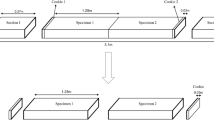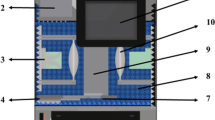Abstract
Lumber moisture content (LMC) is the important parameter to judge the dryness of lumber and the quality of wooden products. Nevertheless the data acquired are mostly redundant and incomplete because of the complexity of the course of drying, by interference factors that exist in the dryness environment and by the physical characteristics of the lumber itself. To improve the measuring accuracy and reliability of LMC, the optimal support vector machine (SVM) algorithm was put forward for regression analysis LMC. Environmental factors such as air temperature and relative humidity were considered, the data of which were extracted with the principle component analysis method. The regression and prediction of SVM was optimized based on the grid search (GS) technique. Groups of data were sampled and analyzed, and simulation comparison of forecasting performance shows that the main component data were extracted to speed up the convergence rate of the optimum algorithm. The GS-SVM shows a better performance in solving the LMC measuring and forecasting problem.






Similar content being viewed by others
References
Ataei M, Osanloo M (2004) Using a combination of genetic algorithm and the grid search method to determine optimum cutoff grades of multiple metal deposits. Int J Surf Min Reclam Environ 18:60–78
Awadalla HSF, El-Dib AF, Mohamad MA, Reuss M, Hussein HMS (2004) Mathematical modelling and experimental verification of wood drying process. Energy Convers Manag 45:197–207
Beyramysoltan S, Rajkó R, Abdollahi H (2013) Investigation of the equality constraint effect on the reduction of the rotational ambiguity in three-component system using a novel grid search method. Anal Chim Acta 791:25–35
Camdevyren H, Demyr N, Kanik A, Keskyn S (2005) Use of principal component scores in multiple linear regression models for prediction of Chlorophyll-a in reservoirs. Ecol Model 181:581–589
Chen GY, Xie WF (2007) Pattern recognition with SVM and dual-tree complex wavelets. Image Vis Comput 25:960–966
Dahmani H, Selouani S, Doghmane N, O’Shaughnessy D, Chetouani M (2014) On the relevance of using rhythmic metrics and SVM to assess dysarthric severity. Int J Biom 6:248–271
Diosan L, Rogozan A, Pecuchet JP (2010) Learning SVM with complex multiple kernels evolved by genetic programming. Int J Artif Intell Tools 19:647–677
Fox SB, Culha M, Sepaniak MJ (2001) Development of a grid search molecular mechanics modeling strategy to study elution behavior in cyclodextrin modified capillary electrophoresis. J Liq Chromatogr Relat Technol 24:1209–1228
Helena B, Pardo R, Vega M, Barrado E, Fernandez JM, Fernandez L (2000) Temporal evolution of groundwater composition in an alluvial aquifer (Pisuerga river, Spain) by principal component analysis. Water Res 34:807–816
Huang SC (2009) Integrating nonlinear graph based dimensionality reduction schemes with SVMs for credit rating forecasting. Expert Syst Appl 36:7515–7518
Isaksson T, Thelandersson S (2013) Experimental investigation on the effect of detail design on wood moisture content in outdoor above ground applications. Build Environ 59:239–249
Kecman V (2005) Support vector machines: an introduction. Springer, Berlin
Klaric M, Pervan S (2012) Improving of maintenance of humidifying system in conventional wood kiln dryers. Drv Ind 63:87–94
Kuang YC, Yu JQ, Hu YC, Wang Y (2013) Research and application of real estate document image classification based on SVMs and KNN. J Inf Comput Sci 10:6093–6100
Liu PY, Jia KB (2013) A motion-characteristics-based unsymmetrical-cross multi-hexagon-grid search algorithm for fast motion estimation. Inf Technol J 12:3128–3133
Lu WZ, Wang WJ, Wang XK, Xu ZB, Leung AYT (2003) Using improved neural network to analyze RSP, NOx and NO2 levels in urban air in Mong Kok, Hong Kong. Environ Monit Assess 87:235–254
Martinovic D, Horman I, Demirdzic I (2001) Numerical and experimental analysis of a wood drying process. Wood Sci Technol 35:143–156
Nelson JDB, Damper RI, Gunn SR, Guo B (2008) Signal theory for SVM kernel design with applications to parameter estimation and sequence kernels. Neurocomputing 72:15–22
Noori R, Kerachian R, Khodadadi A, Shakibayinia A (2007) Assessment of importance of water quality monitoring stations using principal component and factor analyses: a case study of the Karoon River. J Water Wastewater 63:60–69
Noori R, Abdoli MA, Ameri-Ghasrodashti A, Jalili-Ghazizade M (2009a) Prediction of municipal solid waste generation with combination of support vector machine and principal component analysis: a case study of mashhad. Environ Prog Sustain Energy 28:249–258
Noori R, Abdoli MA, Jalili-Ghazizade M, Samifard R (2009b) Comparison of ANN and PCA based multivariate linear regression applied to predict the weekly municipal solid waste generation in Tehran. Iran J Public Health 38:74–84
Noori R, Karbassi AR, Sabahi MS (2010a) Evaluation of PCA and Gamma test techniques on ANN operation for weekly solid waste predicting. J Environ Manag 91:767–771
Noori R, Khakpour A, Omidvar B, Farokhnia A (2010b) Comparison of ANN and principal component analysis-multivariate linear regression models for predicting the river flow based on developed discrepancy ratio statistic. Expert Syst Appl 37:5856–5862
Noori R, Sabahi MS, Karbassi AR, Baghvand A, Zadeh HT (2010c) Multivariate statistical analysis of surface water quality based on correlations and variations in the data set. Desalination 260:129–136
Noori R, Karbassi AR, Moghaddamnia A, Han D, Zokaei-Ashtiani MH, Farokhnia A, Gousheh MG (2011) Assessment of input variables determination on the SVM model performance using PCA, Gamma test, and forward selection techniques for monthly stream flow prediction. J Hydrol 401:177–189
Noori R, Karbassi AR, Khakpour A, Shahbazbegian M, Badam HMK, Vesali-Naseh M (2012) Chemometric analysis of surface water quality data: case study of the gorganrud river basin, Iran. Environ Model Assess 17:411–420
Noori R, Deng Z, Kiaghadi A, Kachoosangi F (2015) How reliable are ANN, ANFIS, and SVM techniques for predicting longitudinal dispersion coefficient in natural rivers? J Hydraul Eng 142:04015039
Ouyang Y (2005) Evaluation of river water quality monitoring stations by principal component analysis. Water Res 39:2621–2635
Patra S, Bruzzon L (2014) A novel SOM-SVM-based active learning technique for remote sensing image classification. IEEE Trans Geosci Remote Sens 52:6899–6910
Pouteau R, Collin A (2013) Spatial location and ecological content of support vectors in an SVM classification of tropical vegetation. Remote Sens Lett 4:686–695
Rakotomamonjy A (2007) Analysis of SVM regression bounds for variable ranking. Neurocomputing 70:1489–1501
Rodi W (2006) Grid-search event location with non-Gaussian error models. Phys Earth Planet Inter 158:55–66
Roy K, Bhattacharya P (2010) Improvement of iris recognition performance using region-based active contours, genetic algorithms and SVMs. Int J Pattern Recognit Artif Intell 24:1209–1236
Salvador CM, Chou CCK (2014) Analysis of semi-volatile materials (SVM) in fine particulate matter. Atmos Environ 95:288–295
Skuratov NV (2008) Intelligent wood drying control: problems and decisions. Drying Technol 26:585–589
Subasi A (2013) Classification of EMG signals using PSO optimized SVM for diagnosis of neuromuscular disorders. Comput Biol Med 43:576–586
Tarjoman M, Fatemizadeh E, Badie K (2013) An implementation of a CBIR system based on SVM learning scheme. J Med Eng Technol 37:43–47
Theodoros E, Tomaso P, Massimiliano P (2002) Regularization and statistical learning theory for data analysis. Comput Stat Data Anal 38:421–432
Vapnik VN (1998) Statistical learning theory, 2nd edn. Wiley, New York
Wang L (2005) Support vector machines: theory and applications. Springer, Berlin, pp 1–48
Zhang DY, Liu YQ, Jun C (2003) Application of single neuron adaptive PID controller during the process of timber drying. J For Res 14:244–248
Zhang DY, Sun LP, Cao J (2006) Modeling of temperature-humidity for wood drying based on time-delay neural network. J For Res 17:141–144
Author information
Authors and Affiliations
Corresponding author
Additional information
Project funding: This paper was supported by the Natural Science Foundation of China (Grant No. 31470715), (Grant No.31470714), and the Fundamental Research Funds for the Central Universities (2572016EBT1).
The online version is available at http://www.springerlink.com
Corresponding editor: Yu Lei.
Rights and permissions
About this article
Cite this article
Zhang, J., Song, W., Jiang, B. et al. Measurement of lumber moisture content based on PCA and GS-SVM. J. For. Res. 29, 557–564 (2018). https://doi.org/10.1007/s11676-017-0448-x
Received:
Accepted:
Published:
Issue Date:
DOI: https://doi.org/10.1007/s11676-017-0448-x




